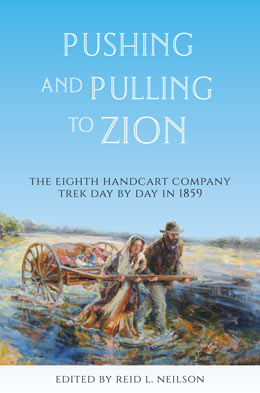
Review
======
Title: Pushing and Pulling to Zion: The Eighth Handcart Company Trek Day by Day in 1859
Editor: Reid L. Neilson
Publisher: Deseret Book/BYU Religious Studies Center
Genre: History
Year Published: 2023
Number of Pages: 394
Binding: Hardcover
ISBN: 9781950304387
Price: 25.99
Reviewed by Ivan Wolfe for the Association of Mormon Letters
The “Eighth Handcart Company” of the title boarded a ship in Liverpool on April 7, 1859, and arrived in the Salt Lake Valley on September 4th. In this book, using the diaries of five members (Thomas McIntyre, Henry Hobbs, Hans Olsen Magleby, Mathias Brock Nilsson, and Robert F. Neslen), editor Ried L. Nelson compiled a day-by-day account, with entries for every day of the journey from each of these men (not every diary is on every day, but every day has multiple entries).
Pushing and Pulling to Zion could have been a dry exercise in primary source reproduction, but instead turns into a clever, varied, and intriguing multi-voiced view of events. Some of these diarists are quite taciturn and sparse, others focus on seemingly small, almost insignificant details. At times major and/or traumatic events are either passed over by one writer but described in either sparse or heart-rendering details by another.
Two not-quite-at-random days from the book will help illustrate this. On Wednesday, June 22 (1859, of course), McIntyre’s brief entry mentions who prayed at the beginning and end of the day and the approximate mileage. Hobbs’ account is quite detailed, mentioning small details like “a small bar of soap was given to each handcart to last through to the valley” and mentions the number (in this case, five) of mudholes they had to deal with along the way that day. Magleby mentions acquiring some potatoes and not much else, and Nilsson (with the shortest entry for that day) just says “crossed Loup Fork on the ferry, and the cattle swam over.”
On September 2, McIntyre mentions a few landmarks (Weber Bridge, Canyon Creek) they crossed and how some of the pioneers met a few friends. Hobbs goes into details on mileage, the food he ate (quite a long list, actually – he must have had quite the appetite), some of the extreme measures taken to get across obstacles, as well as being revived by “whiskey and sugar” at the end of the day. Nilsson mentions some obstacles but gives few details; however, he does end the day with a mention of eating watermelon.
Other days have more dramatic (as well as more pedestrian) events, told (or skipped over) from varying viewpoints. Overall, it makes for an intriguing break from just reading one pioneer journal straight through, giving a fuller picture (including apparent contradictions within, differing viewpoints about, and disparate interpretations of several events) of the overall journey.
Neilson includes copious footnotes (at the bottom of the page rather than at the end of the chapter or in an appendix, something that automatically gets bonus points from this reviewer), explaining historical and geographical references modern readers may not understand. One of the best features of the footnotes are quotes from contemporary travel guides, travelogues, and other reference works that explain/describe how the geographical features appeared to (or, at least, were described by) explorers and other writers of the time period.
Overall, if you are interested in pioneer history or the history of westward expansion in the USA, Pushing and Pulling to Zion: The Eighth Handcart Company Trek Day by Day in 1859 is a must-read. Even if you are not interested in that specific genre, the many voices make this a worthwhile read as a muti-voiced narrative tale of danger, exploration, and survival.
